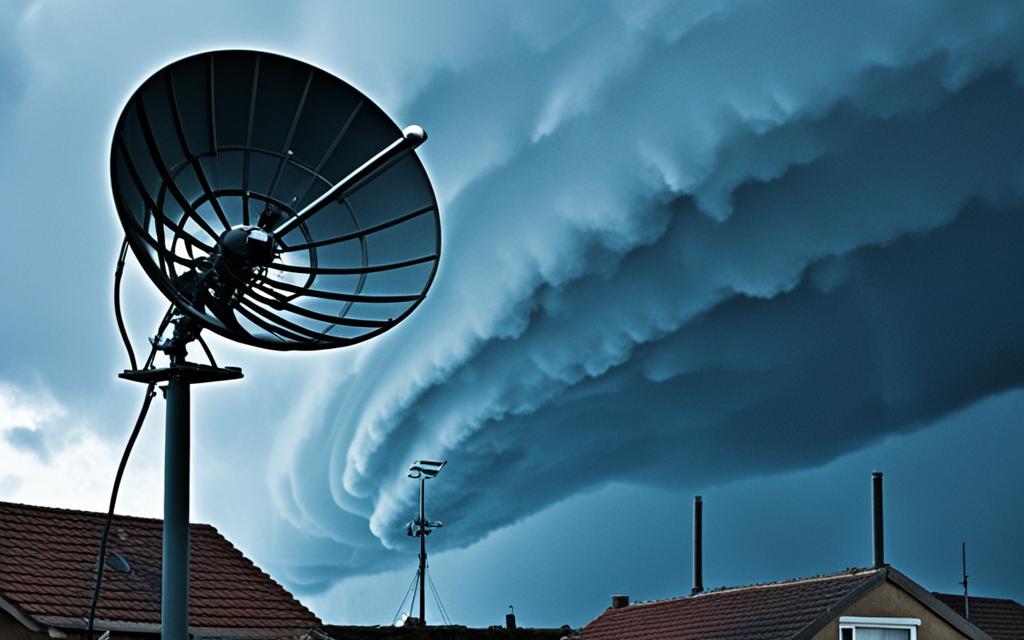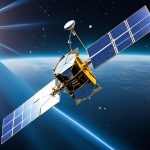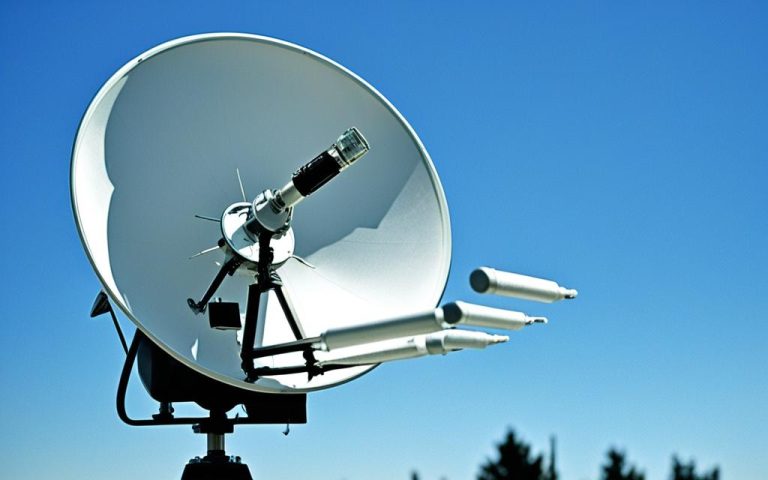The Ka-band is revolutionizing satellite communications, offering extensive benefits for next-generation satellite services. With its larger frequency range and higher data capacities, the Ka-band is paving the way for more efficient solutions in the satellite industry. However, the utilization of Ka-band transmission comes with its challenges, particularly in adverse weather conditions.
One of the key considerations in maximizing Ka-band utilization is the careful design of suitable system configurations to ensure high availability. This is where Ka-band Site Diversity comes into play. By using multiple antenna sites, the RF signals can be seamlessly switched over in case of adverse weather conditions, ensuring uninterrupted satellite service.
To understand the advantages and challenges of Ka-band transmission, as well as the configuration of Ka-band Site Diversity and its impact on overall system performance, let’s delve deeper into the world of Ka-band and its role in the next generation of satellite services.
Advantages of Ka-Band in Satellite Systems
The Ka-band offers several advantages in satellite systems that make it an attractive choice for high-capacity data transmission. With its larger frequency range, Ka-band enables higher data capacities, exceeding 100GBit/s per single satellite, compared to traditional C-band and Ku-band frequencies. This allows for the efficient delivery of large volumes of data, supporting the growing demand for bandwidth-intensive applications in various sectors.
One notable advantage of Ka-band transmission is the use of multiple spot beams. These spot beams enable frequency reuse, allowing for simultaneous transmission of different signals to several geographic areas. By utilizing this feature, satellite operators can optimize the utilization of available spectrum resources and efficiently serve diverse customer needs across wide coverage areas.
“The Ka-band’s higher transmission frequencies also enable highly focused spot beams and smaller antennas.”
This results in more economically efficient solutions at high data rates. The use of highly focused spot beams enables the concentration of signal power, improving signal quality and reducing interference. The smaller antennas required for Ka-band transmission further contribute to cost savings in satellite system deployments.
Overall, the Ka-band offers significant advantages in satellite systems, including:
- Higher data capacities
- Simultaneous transmission to multiple geographic areas
- Frequency reuse
- Highly focused spot beams
- Smaller antennas
These advantages make Ka-band an ideal choice for next-generation satellite services that demand efficient, high-capacity data transmission.
| Advantages of Ka-Band in Satellite Systems |
|---|
| Higher data capacities |
| Simultaneous transmission to multiple geographic areas |
| Frequency reuse |
| Highly focused spot beams |
| Smaller antennas |
Take a look at the diagram below to visualize the advantages of Ka-Band in satellite systems:
Challenges of Ka-Band Transmission
While the Ka-band offers numerous advantages, it also presents certain challenges in satellite communication. One of the primary challenges is the impact of adverse weather conditions on Ka-band transmission, particularly heavy rainfall. Rainfall can cause significant atmospheric losses, exceeding 50dB in some cases, leading to degraded signal quality and reduced transmission efficiency.
This presents a major challenge in maintaining high availability services in Ka-band systems. Conventional fade margin approaches may not be sufficient to compensate for the losses caused by adverse weather conditions. Therefore, it is crucial to employ suitable system configurations that can ensure reliable transmission even in varying weather conditions.
One effective solution to address this challenge is the implementation of Ka-band Site Diversity. This configuration involves the use of multiple antenna sites that can switch over the RF signals in case of adverse weather conditions at the primary site. By having multiple sites strategically located, the system can seamlessly switch to an alternate site with better weather conditions, minimizing the impact of atmospheric losses.
“The implementation of Ka-band Site Diversity is an effective strategy to mitigate the challenges posed by adverse weather conditions in Ka-band transmission,” says Dr. Samantha Miller, a satellite communication expert at XYZ Technologies. “It ensures high availability and improves the reliability of Ka-band systems, enabling uninterrupted transmission even in harsh weather.”
Moreover, the distance between the primary and diverse sites plays a crucial role in the effectiveness of the site diversity configuration. Recommendations suggest maintaining a distance between 30km to 100km to achieve optimal performance and maximum availability.
To further enhance the reliability and availability of Ka-band transmission, technological advancements like bidirectional optical links and RF switching units can be incorporated into the system. These enhancements improve redundancy and ensure seamless switching between different site configurations, ensuring uninterrupted transmission even during challenging weather conditions.

| Challenges | Solutions |
|---|---|
| Adverse weather conditions | Ka-band Site Diversity Optical Delay Lines RF-over-fiber systems |
| Atmospheric losses | Implementing suitable fade margin approaches |
| Reduced signal quality | Utilizing highly focused spot beams and smaller antennas |
In summary, while Ka-band transmission provides significant benefits, it is important to acknowledge and address the challenges it presents, primarily related to adverse weather conditions. By implementing suitable system configurations like Ka-band Site Diversity and leveraging technological advancements such as bidirectional optical links, the reliability and availability of Ka-band transmission can be greatly enhanced.
Ka-Band Site Diversity Configuration
Ka-Band Site Diversity offers a reliable solution for mitigating the effects of adverse weather conditions in satellite communications. This configuration involves the use of two antenna sites – a main site and a diverse site, strategically located at a distance from each other. In the event of unfavorable weather conditions affecting the main site, the RF signals are seamlessly switched over to the diverse site, ensuring uninterrupted service.
The distance between the main and diverse sites is a critical factor in determining the effectiveness of the diversity configuration. For optimal performance, it is generally recommended to maintain a distance between 30km to 100km. This range allows for a suitable balance between site diversity and signal integrity, ensuring maximum availability and system reliability.
To further enhance the configuration, additional components can be incorporated. Bidirectional optical links play a crucial role in establishing a robust connection between the main and diverse sites. These links enable the transmission of RF signals over optical fibers, offering higher resilience against adverse conditions and minimizing signal loss.
RF switching units facilitate the seamless switching of signals between the main and diverse sites, ensuring a seamless transition without interruptions. By implementing equipment redundancy, system reliability and availability can be further increased, ensuring uninterrupted service even in challenging conditions.
Sample Ka-Band Site Diversity Configuration
Based on the recommended distance range of 30km to 100km, the following table illustrates a sample Ka-Band Site Diversity configuration:
| Main Site | Diverse Site | Distance |
|---|---|---|
| Location A | Location B | 50km |
| Location C | Location D | 65km |
| Location E | Location F | 80km |
The table above demonstrates three sample configurations with varying distances between the main and diverse sites. Each configuration is designed to ensure reliable site diversity, maintaining maximum availability of Ka-band communication services.
By implementing Ka-Band Site Diversity configurations that incorporate suitable distances, bidirectional optical links, RF switching units, and equipment redundancy, satellite service providers can maximize the availability and reliability of their Ka-band systems. This approach ensures uninterrupted communication services even in adverse weather conditions, enhancing customer satisfaction and overall network efficiency.
Ka-Band and Fiber Connectivity
To enhance the reliability and availability of Ka-band systems, RF L-band signals are often transmitted via optical fiber. This allows for the use of optical Delay Lines to equalize time delays and bidirectional transmission of multiple RF signals over one optical fiber using Dense Wavelength Division Multiplexing technology. By leveraging fiber connectivity, Ka-band systems can achieve higher resiliency, improved network uptime, and increased overall usable satellite network capacity.
Ka-band systems can benefit significantly from the integration of fiber connectivity. Transmitting RF L-band signals through optical fibers offers several advantages in terms of system reliability and performance. One such advantage is the ability to use optical Delay Lines, which help equalize time delays and ensure accurate signal synchronization. This is crucial for maintaining the quality and integrity of the transmitted data.
Additionally, fiber connectivity enables bidirectional transmission of multiple RF signals over a single optical fiber. This is achieved through the use of Dense Wavelength Division Multiplexing (DWDM) technology, which allows for the efficient multiplexing and demultiplexing of different wavelengths of light. By leveraging DWDM technology, Ka-band systems can make the most out of available bandwidth and increase overall usable satellite network capacity.
The integration of fiber connectivity in Ka-band systems also enhances resiliency and network uptime. Fiber optic cables are known for their robustness and resistance to external interference, making them less susceptible to signal degradation caused by factors like adverse weather conditions. This results in improved reliability and ensures uninterrupted service for end-users.
Moreover, fiber connectivity provides scalability for future network expansion. As the demand for satellite communication services continues to grow, Ka-band systems will need to accommodate higher data capacities and increased traffic. By leveraging fiber optics, these systems can easily scale to meet the evolving needs of users and support the development of next-generation satellite services.
Key Benefits of Ka-Band and Fiber Connectivity:
- Improved reliability and availability of Ka-band systems
- Higher resiliency and network uptime
- Increased overall usable satellite network capacity
- Enhanced signal synchronization and accuracy
- Efficient bidirectional transmission of multiple RF signals
- Robustness and resistance to external interference
- Scalability for future expansion and growth
By integrating fiber connectivity into Ka-band systems, satellite service providers can optimize their infrastructure, deliver superior performance, and meet the demands of today’s data-intensive applications.
Conclusion
Maximizing Ka-Band Utilization is crucial for the success of next-generation satellite services. Despite the inherent challenges posed by adverse weather conditions, innovative system configurations like Ka-band Site Diversity can ensure high availability and reliable transmission. By leveraging advanced technologies such as fiber connectivity, optical Delay Lines, and RF-over-fiber systems, Ka-band systems can achieve higher resiliency, improve network uptime, and offer more competitive solutions that meet a broader range of customer needs.
Adverse weather conditions, particularly rainfall, can severely impact Ka-band transmission, causing significant losses and degrading service quality. However, the implementation of Ka-band Site Diversity, which involves the use of multiple antenna sites, allows for seamless switching of RF signals during adverse weather events, ensuring uninterrupted connectivity and high availability.
In addition to Ka-band Site Diversity, the integration of fiber connectivity further enhances the reliability and resilience of Ka-band systems. Optical Delay Lines play a critical role in equalizing time delays, while RF-over-fiber technology enables efficient bidirectional transmission of multiple RF signals over a single optical fiber. This combination not only improves network uptime but also maximizes the overall usable capacity of the satellite network.
In conclusion, by carefully designing suitable system configurations and leveraging advanced technologies like Ka-band Site Diversity and fiber connectivity, satellite service providers can overcome the challenges associated with Ka-band transmission. Maximizing Ka-Band Utilization not only ensures high availability and reliable transmission but also positions satellite services for future growth and success in meeting the evolving needs of customers.
FAQ
What are the advantages of Ka-Band in satellite systems?
The Ka-band offers a larger frequency range, allowing for higher data capacities exceeding 100GBit/s per single satellite. It enables frequency reuse and simultaneous transmission of different signals to several geographic areas. Additionally, the high transmission frequencies of Ka-band allow for highly focused spot beams and smaller antennas, resulting in more economically efficient solutions at high data rates.
What challenges does Ka-Band transmission face?
Adverse weather conditions, particularly rainfall, can severely degrade Ka-band transmission, causing high atmospheric losses. These losses can exceed 50dB, making it difficult to maintain high availability services. Conventional fade margin approaches may not be sufficient to compensate for the losses. Suitable system configurations, such as Ka-band Site Diversity, need to be carefully designed to ensure reliable transmission in varying weather conditions.
What is the Ka-Band Site Diversity configuration?
Ka-band Site Diversity involves the use of two antenna sites – a main site and a diverse site. In the event of adverse weather conditions at the main site, the RF signals are switched over to the diverse site. The distance between the main and diverse sites plays a crucial role in the performance of the diversity configuration. Generally, a distance between 30km to 100km is recommended to ensure reliable site diversity and maximum availability. Configurations can be further enhanced with bidirectional optical links, RF switching units, and equipment redundancy to increase reliability and availability.
How does Ka-Band utilize fiber connectivity?
To enhance the reliability and availability of Ka-band systems, RF L-band signals are often transmitted via optical fiber. This allows for the use of optical Delay Lines to equalize time delays and bidirectional transmission of multiple RF signals over one optical fiber using Dense Wavelength Division Multiplexing technology. By leveraging fiber connectivity, Ka-band systems can achieve higher resiliency, improved network uptime, and increased overall usable satellite network capacity.



















